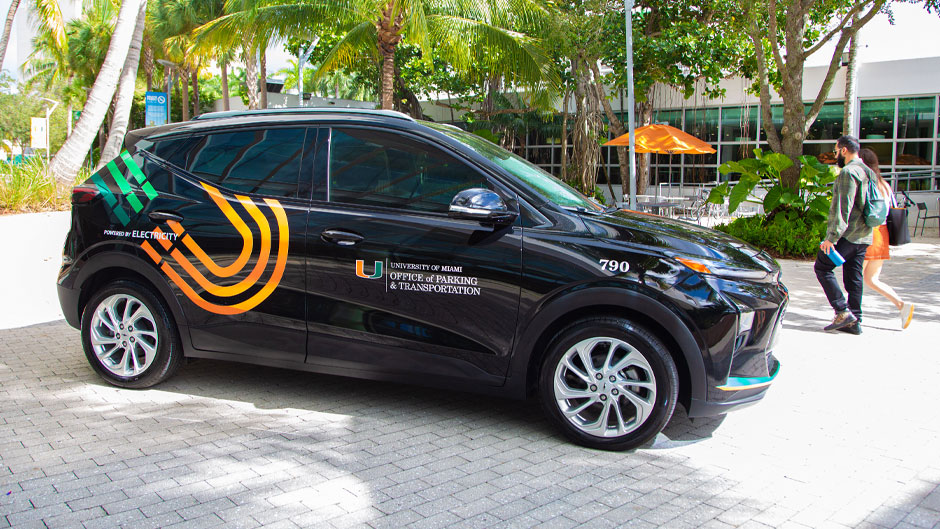Some cars turn heads by revving their engines with a throaty growl and plumes of exhaust. Two new cars on the Coral Gables Campus are attracting attention in a different way—with a visual exclamation of the power and potential of electricity.
Sporting distinct graphics designed by the Office of University Communications, two Chevy Bolts are the first all-electric vehicles (EVs) in the Office of Parking and Transportation’s fleet. They are used for the motorist assistance program, parking enforcement, and event support—all functions that involve significant amounts of idling.
“For every hour [gas vehicles] idle, we burn 30 miles worth of fuel,” said Eli Stephan, director of parking and transportation. “When you think about enforcing parking for 6 to 7 hours, idling most of the time, think about how much fuel is consumed. EVs use very little power when stopped, so this makes sense for how we’re using these vehicles.”
Stephan noted that EVs also make financial sense. Idling increases wear and tear on gas vehicles, adding to maintenance costs. As cars in the fleet reach retirement age or need repairs, Stephan and his team are working with the Office of Sustainability to replace them with electric options.
They landed on the Chevy Bolt because it is priced affordably, has received favorable reviews, and can be charged using either a standard 120-volt wall outlet or a more powerful and quicker 240-volt charger. This dual charging feature offers flexibility while the University continues to build its charging infrastructure. Presently there are nine 240-volt charging stations, each with two chargers, on the Coral Gables Campus. Anyone with a valid parking permit or visitor’s pass may use them for free through a partnership between the University and the Florida Power & Light (FPL) EVolution program.
Another partnership with FPL, called SolarTogether, is enabling the University to reduce its reliance on electricity generated from carbon sources, known as scope 2 emissions. EVs can help tackle scope 1 emissions.
“In carbon accounting, scope 1 emissions are directly emitted on campus, like the ones coming from the use of natural gas, propane, gasoline, and diesel,” explained Teddy L’Houtellier, sustainability director at the University. “SolarTogether allows us to drastically reduce our scope 2 emissions, but we still have work to do for scope 1. The transition to an electric fleet is part of this strategy.”
L’Houtellier noted that the Department of Facilities Operations and Planning, which includes the Office of Sustainability and the Office of Parking and Transportation, is planning to transition its fleet to electric vehicles.
“We hope our efforts inspire other departments to consider adding hybrid or electric vehicles to their fleet,” L’Houtellier said.
To spark university-wide excitement for the EVs, the Chevy Bolts were wrapped in a distinctive design.
“We partnered with University Communications to develop a new design that would clearly and effectively communicate our mission of sustainability, community, electricity, and the U,” Stephan said. “The words ‘powered by electricity’ are a thoughtful message; the ends of the orange and green bars form a letter E for electricity; and the curved orange elements convey images of electrical cords, a sense of community, an aerial view of roads, and the shape of a U.”
In designing the vehicles, Tina Talavera, art director in the Office of University Communications, needed to think in a multidimensional way.
“A lot of EVs have really fluid areas that are concave, as well as elements like doors and windows,” said Talavera, who also was the lead designer for the Hurry ’Canes Shuttles. “It’s very different than designing for a commercial van, for example, which has mostly flat surfaces. Placement is paramount. We want to make sure we avoid pitfalls of placing elements on areas that can get impeded.”
Talavera also noted that designing for a moving canvas is different than for a static one. Placing the orange and green lines in a diagonal configuration, for example, enhances their impact while in motion—and at various distances. The text is simple and at an optimal size for legibility. Colors and shapes express University spirit.
“This was an exciting project because it gave us a platform to push one of our core missions, which is sustainability, while also amplifying the University’s brand,” Talavera said.
“This process has left me in awe of what we can create and showcase at the University,” said Thierry Bien-Aime, mobility manager in the Office of Parking and Transportation, who oversees the transport of more than 3,000 people each day to and throughout the Coral Gables Campus. “We are already seeing an uptick in EVs on campus, and this is another giant leap forward in being a green U.”

